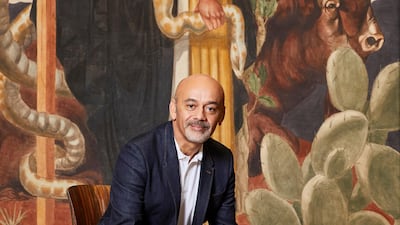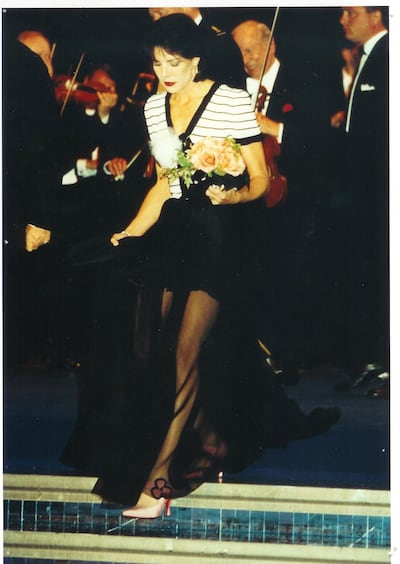“It was sort of by accident. I never plan things,” Christian Louboutin tells me.
We are sitting in the back of a car, racing between events. It has been a long day for the designer but, fittingly for a shoe maker, he is so refreshingly grounded that even though his diary is packed, he has still found time for this interview. Hence the car ride.
We are discussing Christian Louboutin, Exhibition[niste], which opened on February 26 and will run until Sunday, July 26, at the Palais de la Porte Dorée, in Paris's 12th arrondissement. It tells the story of both the designer's career and the myriad things that inspire him.

"The exhibition came about because of the relationship we have with the museum and [executive director] Hélène Orain. Suddenly, it made so much sense. I have been proposed lots of places [to hold an exhibition], but I hadn't realised how personal the Palais was to me. And to come back to your roots is important. That's why this exhibition isn't just about my work, but also about my roots, about where I come from."
Louboutin knows the venue well, having attended school just behind it, and spent countless hours wandering its magnificent Art Deco halls. It is here, he claims, that he was first made aware of the power of shoes, as something to be admired – as in the beautiful drawings on the Palais walls – but also feared, like the sign warning of the danger of heels to the precious parquet floor. This duality, of being feted yet demonised, has proved a keystone.

Born in Paris in 1963 as the youngest child of a cabinet maker, Louboutin had three older sisters. Rebellious and free-spirited, he left home at age 12, and after struggling at school, was eventually expelled. Following that, he spent a year travelling around India, before returning to Paris in the mid-1980s to start working in the studio of Charles Jourdan, then a shoemaker for Christian Dior.
After making excellent contacts across the dance floors of Parisian nightclubs, Louboutin left the studio to become a freelance designer, working for brands including Chanel, Yves Saint Laurent and Roger Vivier. He credits the latter for teaching him about the importance and value of craftsmanship.
In 1992, Louboutin opened his own boutique in Paris, but it was not until the following year that his most famous design emerged when, legend has it, Louboutin picked up a bottle of nail varnish and slicked the contents on the sole of a shoe. The glossy and provocative result quickly caught the attention of Princess Caroline of Monaco and Madonna, propelling the designer into the public eye. Since then, Louboutin has expanded his empire to include bags (launched in 2003), men’s shoes (2011) and even cosmetics – beginning with (what else?) a red nail varnish in 2014. The line now also includes lipsticks, eyeliners, a mascara and eye and lip pencils.
Louboutin has never been bothered by convention, and his resulting shoes tiptoe a delicate line between power, provocation and beautiful, nay extraordinary, workmanship. The French designer often gleans inspiration from his travels – what sets him apart, however, is that when it comes to creating the final designs, he will return to that region and task local artisans with the work. Be it India, Senegal or Mexico, regional artisans are given ownership of their heritage and unique know-how. Most recently, this showed in collection inspired by the Kingdom of Bhutan (charmingly called LouBhutan's) and released to great fanfare in October.
Created in collaboration with students from the School of the Thirteen Royal Arts and Crafts, in the Bhutanese capital, Thimphu, the 250 unique pairs were lavished with the scrolls, intricate waves and motifs of the kingdom. "I had always wanted to go to Bhutan and finally went eight or nine years ago. I visited the school and it was beautiful. Someone I know was getting married, so I thought to do a few pairs of shoes for her, with symbols of well-being, wellness and love. One pair was painted on silk, another was woven and another was embroidered with silk thread. They were beautiful. Then I sent them, but she never received them. She doesn't even know and I don't even dare tell her."
Blessed with a curious, open mind and a bold eye for pattern and colour, it is no surprise that a streak of mischief and fun runs through the designer's work (evident in pieces such as the lipstick in his cosmetics collection that doubles as a necklace). "It is very natural, it is very how I am. I really think that fashion shouldn't be adding to the problems. It is not because we are doing something that is fantastically useless, or that we have no interest in what is happening in the world, but it is important that some things are dedicated to making people smile, to making them happy. I have really decided this is my mission. Fashion is one of the few segments of entertainment that has to be kept as an antidote."Unperturbed at this setback, he instead seized the opportunity to bring Bhutanese arts to a wider audience. "I was really pleased with how they turned out and thought I should probably do something with these artisans. I had started out not thinking to do a capsule collection, but to do something special for one person," he explains.
Part of that antidote will be the exhibition itself. With almost three decades of work to edit, Louboutin called on an expert, Olivier Gabet, director of the Musée des Arts Décoratifs in Paris, and curator of the recent 10,000 Years of Luxury exhibition at Louvre Abu Dhabi. "It was always important have a curator because it is an editor. Emotion is a big thing in an exhibition, and you cannot just rely on your own. Olivier arrived and was very clear about what was missing and what was important. For instance, I was thinking to mix my early work with my later work, but Olivier said that would make it look really faded. He added a lot of things we had never thought about."
Part of Louboutin’s journey has always been collaborations so, fittingly, there are plenty in the show. Once more he teams up with film director David Lynch (for the first time since 2007), while new tie-ups include projects with New Zealand artist Lisa Reihana and miniaturist Imran Qureshi. Seemingly drawn to contradiction, Louboutin describes Qureshi’s work as: “Beautiful and also, which I really like, an opposition of something dark and something very delicate.”
As part of the exhibition, Gabet also tackles the thorny issue of Louboutin’s own name now being bigger than the man himself. Now part of everyday language as an adjective, the designer’s surname is synonymous with a pair of shoes (like Hoover has come to denote a vacuum cleaner and Biro a pen), and therefore is no longer his own. “I am not sure I am loving it,” Louboutin muses.
Over his three-decade career, Louboutin has proven to be a tireless worker, with a deep respect for those who have the skill to make things with their own hands. “It has been ingrained in my DNA without me realising it. My father was a cabinet maker – an artisan – so it is very important to me. I do not understand the difference between the word artisan and the word artist. I don’t see why is there a fracture between these two. To use something doesn’t make it degrading for me.”
As I leave to let the designer continue on to his next appointment, I am struck that his words could almost be life advice. This is a man who never plans things, refuses to follow convention, and yet has carved a wildly successful empire doing exactly what he wants. Interestingly, of all his thousands of designs, the most in-demand Louboutin is the Pigalle Pump, with a 120 millimetre heel. Anyone who has worn them will tell you they are beautifully, provocatively high, forcing a languid but tenacious gait. One must walk slowly, but courageously. In short, one must take one's time.Committed to a schedule that demands new collections four times a year, one could forgive him for expecting those around him follow the same punishing timetable. The opposite is true. "The project in Bhutan took six years, and it didn't matter. We rush people all the time for everything and it's not fair. You can't put people under pressure all the time for no reason. Maybe I would have liked to have the collection a year before, but what is the difference? It is better that everyone is happy and ready, rather than rushing, and driving people crazy. When there is no reason, I want people to take their time."
We speak of not knowing anyone until we have walked a mile in their shoes. Having walked far more than that in some of Mr Louboutin’s, I am beginning to think he might well be on to something.




